Functionalized Ultrasmall Iron Oxide Nanoparticles for T1-Weighted Magnetic Resonance Imaging of Tumor Hypoxia
Abstract
1. Introduction
2. Materials and Methods
2.1. Materials
2.2. Cells and Animals
2.3. Synthesis of Hypoxia-Sensitive Ligand (Met)
2.4. Synthesis of Ultrasmall Fe3O4 Nanoparticles
2.5. Ligand Exchange to Prepare PEGylated Fe3O4-Mal Nanoparticles
2.6. Preparation of Fe3O4-Met-Cy5.5 and Fe3O4-Cys-Cy5.5 Nanoprobes
2.7. Characterizations
3. Results and Discussion
3.1. Synthesis and Characterization of Hypoxia-Sensitive Ligand
3.2. Construction and Characterization of Hypoxia-Sensitive MRI Nanoprobes
3.3. In Vitro Specificity and Cytotoxicity of Hypoxia-Sensitive MRI Nanoprobes
3.4. In Vivo T1-Weighted MRI of Tumors
4. Conclusions
Supplementary Materials
Author Contributions
Funding
Institutional Review Board Statement
Informed Consent Statement
Data Availability Statement
Acknowledgments
Conflicts of Interest
Sample Availability
References
- Gilkes, D.M.; Semenza, G.L.; Wirtz, D. Hypoxia and the Extracellular Matrix: Drivers of Tumour Metastasis. Nat. Rev. Cancer 2014, 14, 430–439. [Google Scholar] [CrossRef]
- Vaupel, P.; Briest, S.; Hockel, M. Hypoxia in Breast Cancer: Pathogenesis, Characterization and Biological/Therapeutic Implications. Wien. Med. Wochenschr. 2002, 152, 334–342. [Google Scholar] [CrossRef] [PubMed]
- Vaupel, P.; Harrison, L. Tumor Hypoxia: Causative Factors, Compensatory Mechanisms, and Cellular Response. Oncologist 2004, 9 (Suppl. S5), 4–9. [Google Scholar] [CrossRef] [PubMed]
- Jubb, A.M.; Buffa, F.M.; Harris, A.L. Assessment of Tumour Hypoxia for Prediction of Response to Therapy and Cancer Prognosis. J. Cell. Mol. Med. 2010, 14, 18–29. [Google Scholar] [CrossRef]
- Ma, T.; Zhang, P.; Hou, Y.; Ning, H.; Wang, Z.; Huang, J.; Gao, M. “Smart” Nanoprobes for Visualization of Tumor Microenvironments. Adv. Healthc. Mater. 2018, 7, e1800391. [Google Scholar] [CrossRef] [PubMed]
- Phung, C.D.; Tran, T.H.; Pham, L.M.; Nguyen, H.T.; Jeong, J.H.; Yong, C.S.; Kim, J.O. Current Developments in Nanotechnology for Improved Cancer Treatment, Focusing on Tumor Hypoxia. J. Control. Release 2020, 324, 413–429. [Google Scholar] [CrossRef] [PubMed]
- Koukourakis, M.I.; Giatromanolaki, A.; Danielidis, V.; Sivridis, E. Hypoxia Inducible Factor (HIF1 alpha and HIF2 alpha) and Carbonic Anhydrase 9 (CA9) Expression and Response of Head-neck Cancer to Hypofractionated and Accelerated Radiotherapy. Int. J. Radiat. Biol. 2008, 84, 47–52. [Google Scholar] [CrossRef]
- Rey, S.; Schito, L.; Koritzinsky, M.; Wouters, B.G. Molecular Targeting of Hypoxia in Radiotherapy. Adv. Drug Deliv. Rev. 2017, 109, 45–62. [Google Scholar] [CrossRef] [PubMed]
- Vaupel, P. The Role of Hypoxia-Induced Factors in Tumor Progression. Oncologist 2004, 9, 10–17. [Google Scholar] [CrossRef] [PubMed]
- Rankin, E.B.; Giaccia, A.J. Hypoxic Control of Metastasis. Science 2016, 352, 175–180. [Google Scholar] [CrossRef]
- Vaupel, P.; Schlenger, K.; Knoop, C.; Hockel, M. Oxygenation of Human Tumors: Evaluation of Tissue Oxygen Distribution in Breast Cancers by Computerized O2 Tension Measurements. Cancer Res. 1991, 51, 3316–3322. [Google Scholar]
- Olive, P.L.; Banath, J.P.; Aquino-Parsons, C. Measuring Hypoxia in Solid Tumours—Is there a gold standard? Acta Oncol. 2001, 40, 917–923. [Google Scholar] [PubMed]
- Sun, X.; Niu, G.; Chan, N.; Shen, B.; Chen, X. Tumor Hypoxia Imaging. Mol. Imaging Biol. 2011, 13, 399–410. [Google Scholar] [CrossRef] [PubMed]
- Liu, J.N.; Bu, W.; Shi, J. Chemical Design and Synthesis of Functionalized Probes for Imaging and Treating Tumor Hypoxia. Chem. Rev. 2017, 117, 6160–6224. [Google Scholar] [CrossRef] [PubMed]
- Cheng, M.H.Y.; Mo, Y.; Zheng, G. Nano versus Molecular: Optical Imaging Approaches to Detect and Monitor Tumor Hypoxia. Adv. Healthc. Mater. 2021, 10, e2001549. [Google Scholar] [CrossRef]
- Nan, Y.X.; Zhou, Q.L.; Zhao, W.J.; Lu, Y.B.; Xu, W.J. In Vivo Imaging of Hypoxia Generation Stimulated by Testosterone Using a Micelle-Based Near-Infrared Fluorescent Probe. Sens. Actuators B Chem. 2019, 288, 543–551. [Google Scholar] [CrossRef]
- Berezin, M.Y.; Achilefu, S. Fluorescence Lifetime Measurements and Biological Imaging. Chem. Rev. 2010, 110, 2641–2684. [Google Scholar] [CrossRef]
- Yoshihara, K.; Takagi, K.; Son, A.; Kurihara, R.; Tanabe, K. Aggregate Formation of Oligonucleotides that Assist Molecular Imaging for Tracking of the Oxygen Status in Tumor Tissue. ChemBioChem 2017, 18, 1650–1658. [Google Scholar] [CrossRef] [PubMed]
- Zheng, X.C.; Mao, H.; Huo, D.; Wu, W.; Liu, B.R.; Jiang, X.Q. Successively Activatable Ultrasensitive Probe for Imaging Tumour Acidity and Hypoxia. Nat. Biomed. Eng. 2017, 1, 0057. [Google Scholar] [CrossRef]
- Xiao, P.; Liu, C.; Ma, T.; Lu, X.; Jing, L.; Hou, Y.; Zhang, P.; Huang, G.; Gao, M. A Cyclodextrin-Hosted Ir(III) Complex for Ratiometric Mapping of Tumor Hypoxia In Vivo. Adv. Sci. 2021, 8, 2004044. [Google Scholar] [CrossRef]
- Rajendran, J.G.; Wilson, D.C.; Conrad, E.U.; Peterson, L.M.; Bruckner, J.D.; Rasey, J.S.; Chin, L.K.; Hofstrand, P.D.; Grierson, J.R.; Eary, J.F.; et al. 18F-FMISO and 18F-FDG PET Imaging in Soft Tissue Sarcomas: Correlation of Hypoxia, Metabolism and VEGF Expression. Eur. J. Nuc.l Med. Mol. Imaging 2003, 30, 695–704. [Google Scholar] [CrossRef] [PubMed]
- Halmos, G.B.; de Bruin, L.B.; Langendijk, J.A.; van der Laan, B.F.A.M.; Pruim, J.; Steenbakkers, R.J.H.M. Head and Neck Tumor Hypoxia Imaging by 18F-Fluoroazomycin-arabinoside (18F-FAZA)-PET: A Review. Clin. Nucl. Med. 2014, 39, 44–48. [Google Scholar] [CrossRef]
- Zegers, C.M.; van Elmpt, W.; Szardenings, K.; Kolb, H.; Waxman, A.; Subramaniam, R.M.; Moon, D.H.; Brunetti, J.C.; Srinivas, S.M.; Lambin, P.; et al. Repeatability of Hypoxia PET Imaging Using 18F-HX4 in Lung and Head and Neck Cancer Patients: A Prospective Multicenter Trial. Eur. J. Nucl. Med. Mol. Imaging 2015, 42, 1840–1849. [Google Scholar] [CrossRef] [PubMed]
- Pinto, S.M.; Tome, V.; Calvete, M.J.F.; Castro, M.M.C.A.; Toth, E.; Geraldes, C.F.G.C. Metal-Based Redox-Responsive MRI Contrast Agents. Coord. Chem. Rev. 2019, 390, 1–31. [Google Scholar] [CrossRef]
- Hu, Y.; Mignani, S.; Majoral, J.P.; Shen, M.; Shi, X. Construction of Iron Oxide Nanoparticle-Based Hybrid Platforms for Tumor Imaging and Therapy. Chem. Soc. Rev. 2018, 47, 1874–1900. [Google Scholar] [CrossRef]
- Filippi, M.; Nguyen, D.V.; Garello, F.; Perton, F.; Begin-Colin, S.; Felder-Flesch, D.; Power, L.; Scherberich, A. Metronidazole-Functionalized Iron Oxide Nanoparticles for Molecular Detection of Hypoxic Tissues. Nanoscale 2019, 11, 22559–22574. [Google Scholar] [CrossRef] [PubMed]
- Zhou, H.; Guo, M.; Li, J.; Qin, F.; Wang, Y.; Liu, T.; Liu, J.; Sabet, Z.F.; Wang, Y.; Liu, Y.; et al. Hypoxia-Triggered Self-Assembly of Ultrasmall Iron Oxide Nanoparticles to Amplify the Imaging Signal of a Tumor. J. Am. Chem. Soc. 2021, 143, 1846–1853. [Google Scholar] [CrossRef] [PubMed]
- Park, M.; Lee, N.; Choi, S.H.; An, K.; Yu, S.H.; Kim, J.H.; Kwon, S.H.; Kim, D.; Kim, H.; Baek, S.I.; et al. Large-Scale Synthesis of Ultrathin Manganese Oxide Nanoplates and Their Applications to T1 MRI Contrast Agents. Chem. Mater. 2011, 23, 3318–3324. [Google Scholar] [CrossRef]
- Chen, C.; Ge, J.; Gao, Y.; Chen, L.; Cui, J.; Zeng, J.; Gao, M. Ultrasmall Superparamagnetic Iron Oxide Nanoparticles: A Next Generation Contrast Agent for Magnetic Resonance Imaging. WIREs Nanomed. Nanobiotechnol. 2022, 14, e1740. [Google Scholar] [CrossRef] [PubMed]
- Sandiford, L.; Phinikaridou, A.; Protti, A.; Meszaros, L.K.; Cui, X.; Yan, Y.; Frodsham, G.; Williamson, P.A.; Gaddum, N.; Botnar, R.M.; et al. Bisphosphonate-Anchored PEGylation and Radiolabeling of Superparamagnetic Iron Oxide: Long-Circulating Nanoparticles for In Vivo Multimodal (T1 MRI-SPECT) Imaging. ACS Nano 2013, 7, 500–512. [Google Scholar] [CrossRef]
- Jia, Z.; Song, L.; Zang, F.; Song, J.; Zhang, W.; Yan, C.; Xie, J.; Ma, Z.; Ma, M.; Teng, G.; et al. Active-Target T1-Weighted MR Imaging of Tiny Hepatic Tumor via RGD Modified Ultra-Small Fe3O4 Nanoprobes. Theranostics 2016, 6, 1780–1791. [Google Scholar] [CrossRef] [PubMed]
- Lu, Y.; Xu, Y.J.; Zhang, G.B.; Ling, D.; Wang, M.Q.; Zhou, Y.; Wu, Y.D.; Wu, T.; Hackett, M.J.; Hyo Kim, B.; et al. Iron Oxide Nanoclusters for T1 Magnetic Resonance Imaging of Non-Human Primates. Nat. Biomed. Eng. 2017, 1, 637–643. [Google Scholar] [CrossRef]
- Kim, M.H.; Son, H.Y.; Kim, G.Y.; Park, K.; Huh, Y.M.; Haam, S. Redoxable Heteronanocrystals Functioning Magnetic Relaxation Switch for Activatable T1 and T2 Dual-Mode Magnetic Resonance Imaging. Biomaterials 2016, 101, 121–130. [Google Scholar] [CrossRef] [PubMed]
- Edwards, D.I. Nitroimidazole Drugs-Action and Resistance Mechanisms. I. Mechanisms of Action. J. Antimicrob. Chemother. 1993, 31, 9–20. [Google Scholar] [CrossRef]
- Handley, M.G.; Medina, R.A.; Nagel, E.; Blower, P.J.; Southworth, R. PET Imaging of Cardiac Hypoxia: Opportunities and Challenges. J. Mol. Cell. Cardiol. 2011, 51, 640–650. [Google Scholar] [CrossRef][Green Version]
- Strauss, H.W.; Nunn, A.; Linder, K. Nitroimidazoles for Imaging Hypoxic Myocardium. J. Nucl. Cardiol. 1995, 2, 437–445. [Google Scholar] [CrossRef]
- Jiao, M.X.; Zeng, J.F.; Jing, L.H.; Liu, C.Y.; Gao, M.Y. Flow Synthesis of Biocompatible Fe3O4 Nanoparticles: Insight into the Effects of Residence Time, Fluid Velocity, and Tube Reactor Dimension on Particle Size Distribution. Chem. Mater. 2015, 27, 1299–1305. [Google Scholar] [CrossRef]
- Mallia, M.B.; Mathur, A.; Subramanian, S.; Banerjee, S.; Sarma, H.D.; Venkatesh, M. A Novel [99mTc[triple bond]N]2+ Complex of Metronidazole Xanthate as a Potential Agent for Targeting Hypoxia. Bioorg. Med. Chem. Lett. 2005, 15, 3398–3401. [Google Scholar] [CrossRef]
- Lages, E.B.; de Freitas, M.B.; Goncalves, I.M.; Alves, R.J.; Vianna-Soares, C.D.; Ferreira, L.A.; de Oliveira, M.C.; de Oliveira, R.B. Evaluation of Antitumor Activity and Development of Solid Lipid Nanoparticles of Metronidazole Analogue. J. Biomed. Nanotechnol. 2013, 9, 1939–1944. [Google Scholar] [CrossRef] [PubMed]
- Javani, S.; Barsbay, M.; Ghaffarlou, M.; Mousazadeh, N.; Mohammadi, A.; Mozafari, F.; Rezaeejam, H.; Nasehi, L.; Nosrati, H.; Kavetskyy, T.; et al. Metronidazole Conjugated Bismuth Sulfide Nanoparticles for Enhanced X-Ray Radiation Therapy. J. Drug Deliv. Sci. Technol. 2022, 71, 103336. [Google Scholar] [CrossRef]
- Chen, S.; Zhong, Y.; Fan, W.; Xiang, J.; Wang, G.; Zhou, Q.; Wang, J.; Geng, Y.; Sun, R.; Zhang, Z.; et al. Enhanced Tumour Penetration and Prolonged Circulation in Blood of Polyzwitterion-Drug Conjugates with Cell-Membrane Affinity. Nat. Biomed. Eng. 2021, 5, 1019–1037. [Google Scholar] [CrossRef] [PubMed]
- Wang, G.W.; Zhang, C.; Jiang, Y.F.; Song, Y.; Chen, J.F.; Sun, Y.; Li, Q.Y.; Zhou, Z.X.; Shen, Y.Q.; Huang, P.T. Ultrasonic Cavitation-Assisted and Acid-Activated Transcytosis of Liposomes for Universal Active Tumor Penetration. Adv. Funct. Mater. 2021, 31, 2102786. [Google Scholar] [CrossRef]
- Lu, H.; Stenzel, M.H. Multicellular Tumor Spheroids (MCTS) as a 3D In Vitro Evaluation Tool of Nanoparticles. Small 2018, 14, e1702858. [Google Scholar] [CrossRef] [PubMed]
- Guo, S.; Sun, D.; Ni, D.; Yu, M.; Qian, K.; Zhang, W.; Yang, Y.; Song, S.; Li, Y.; Xi, Z.; et al. Smart Tumor Microenvironment-Responsive Nanotheranostic Agent for Effective Cancer Therapy. Adv. Funct. Mater. 2020, 30, 2000486. [Google Scholar] [CrossRef]
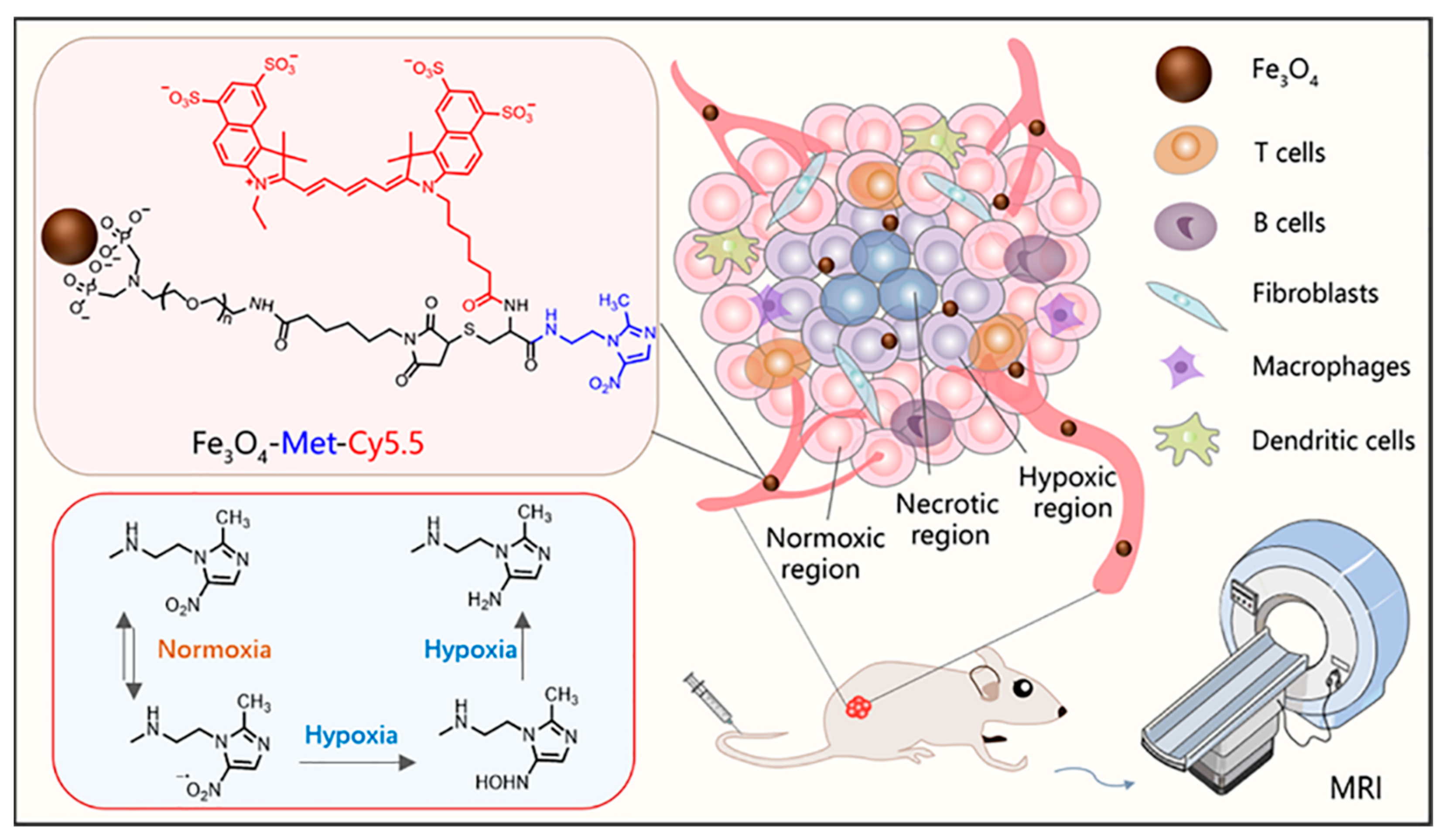
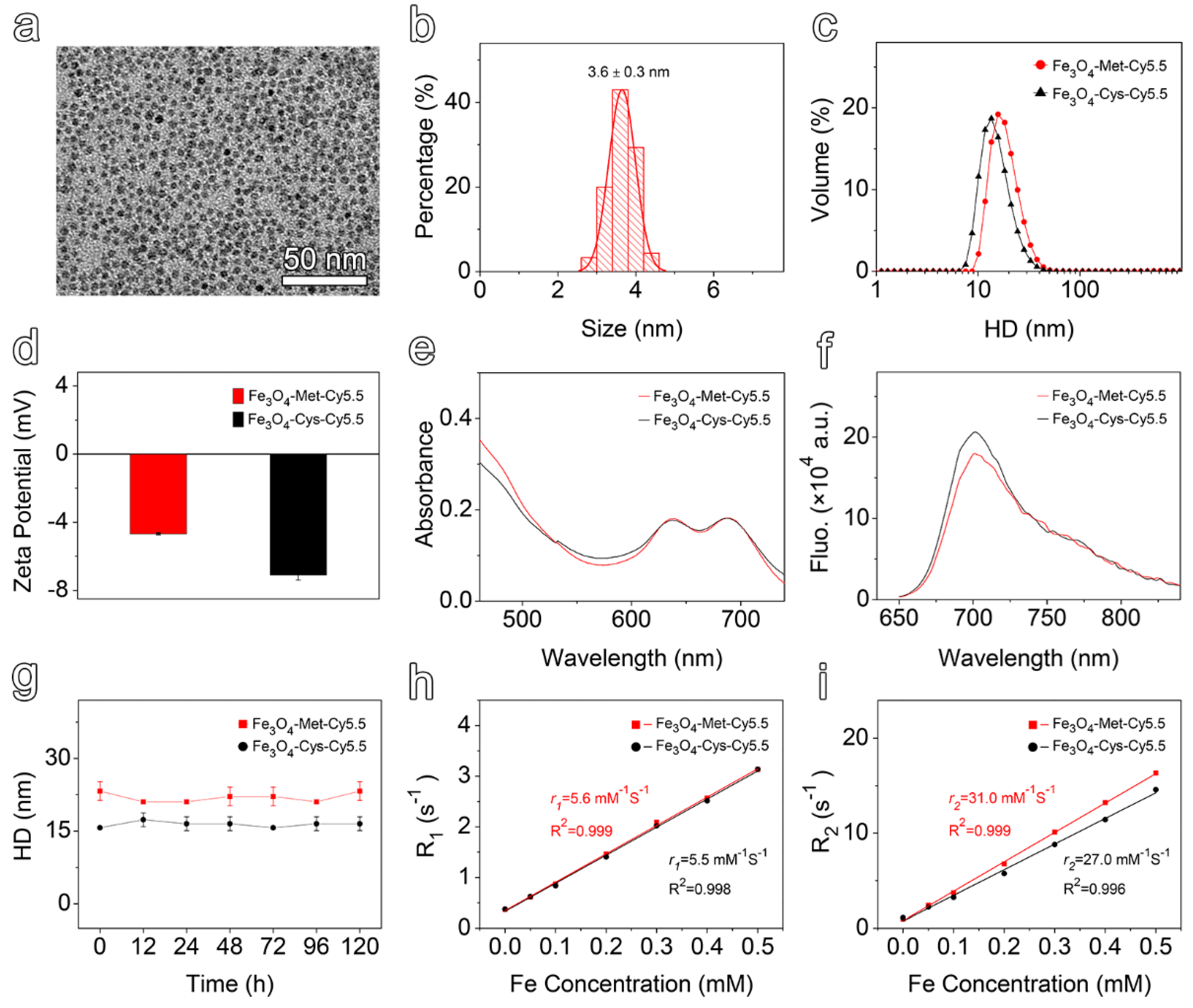
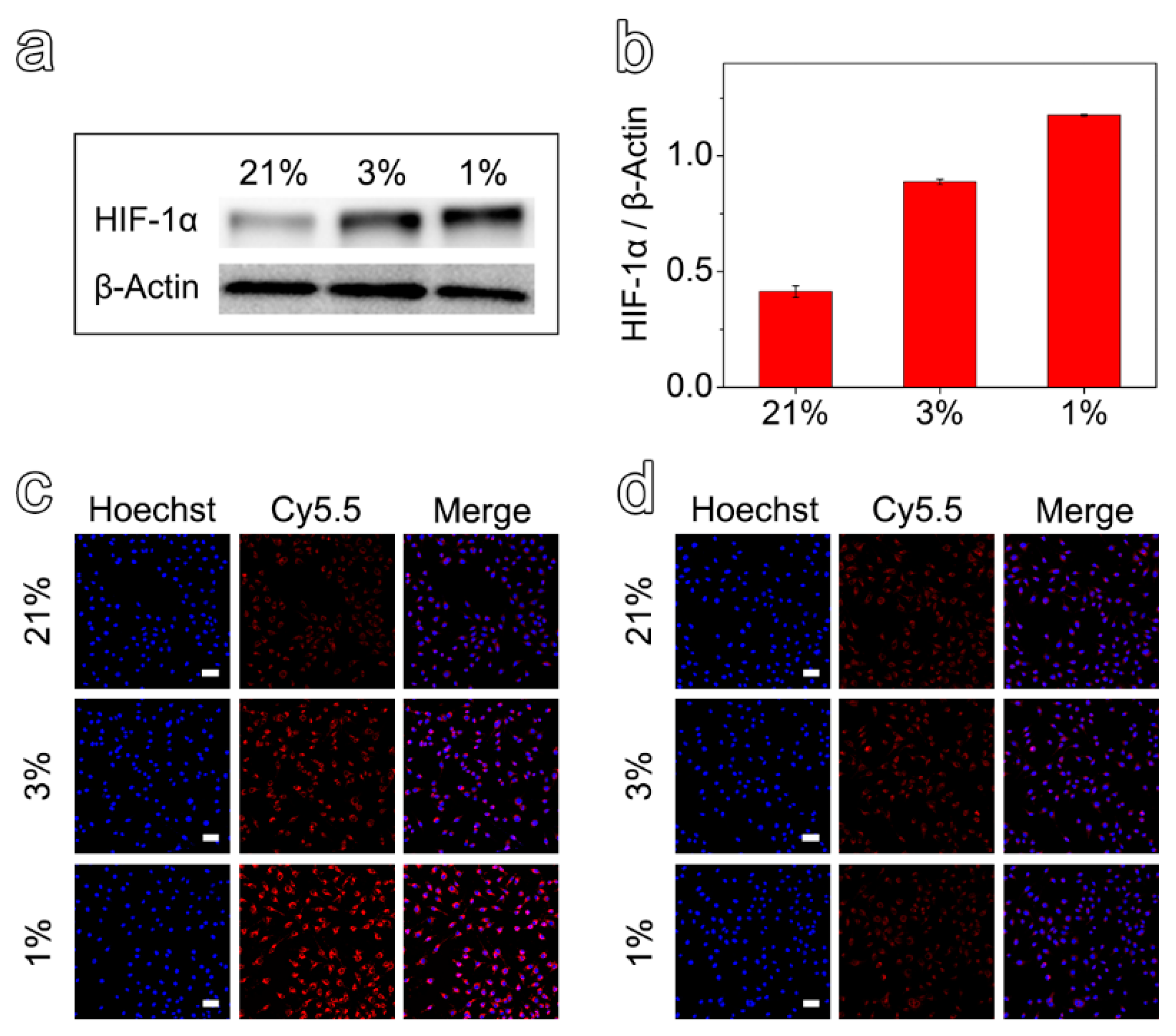
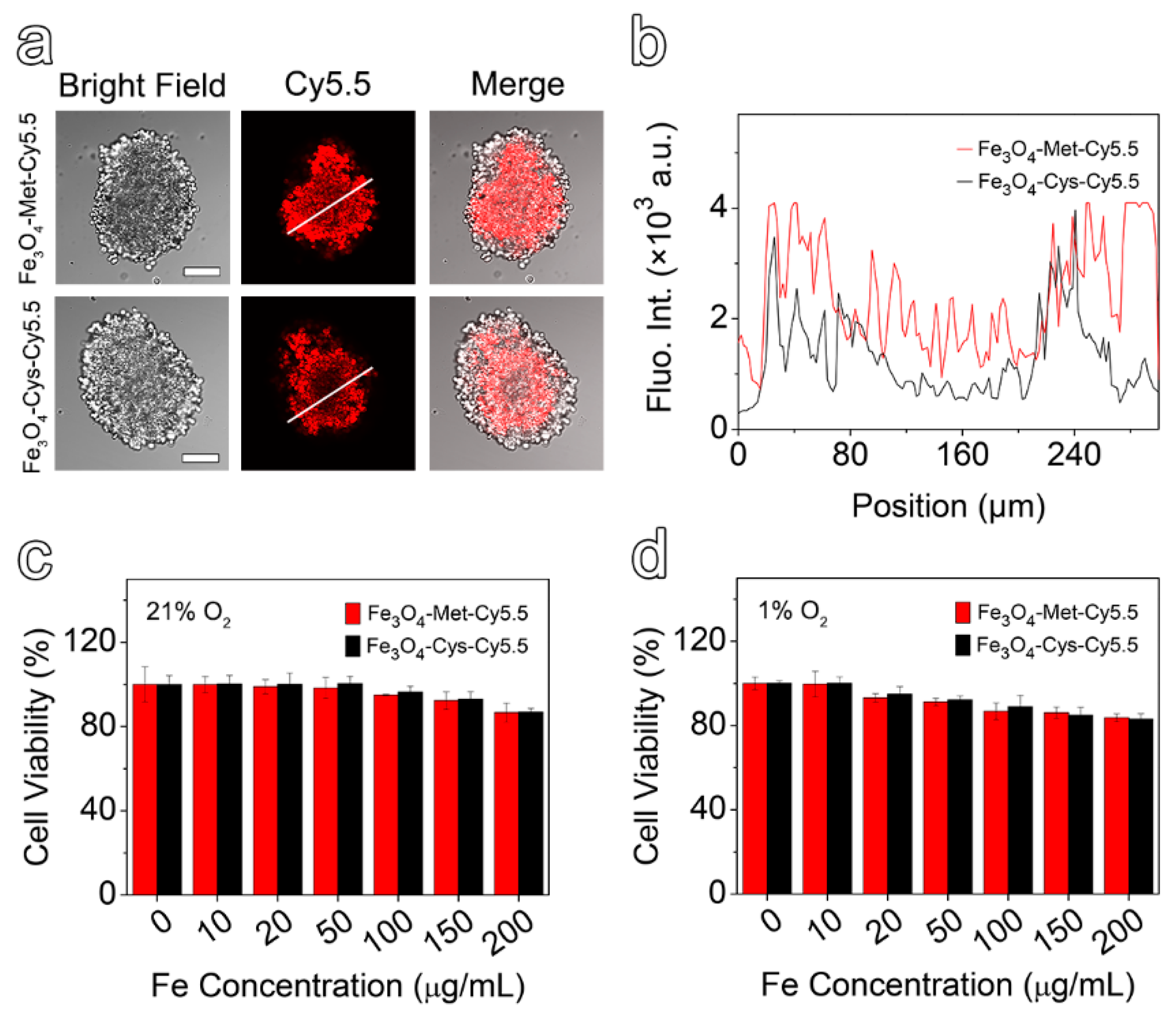
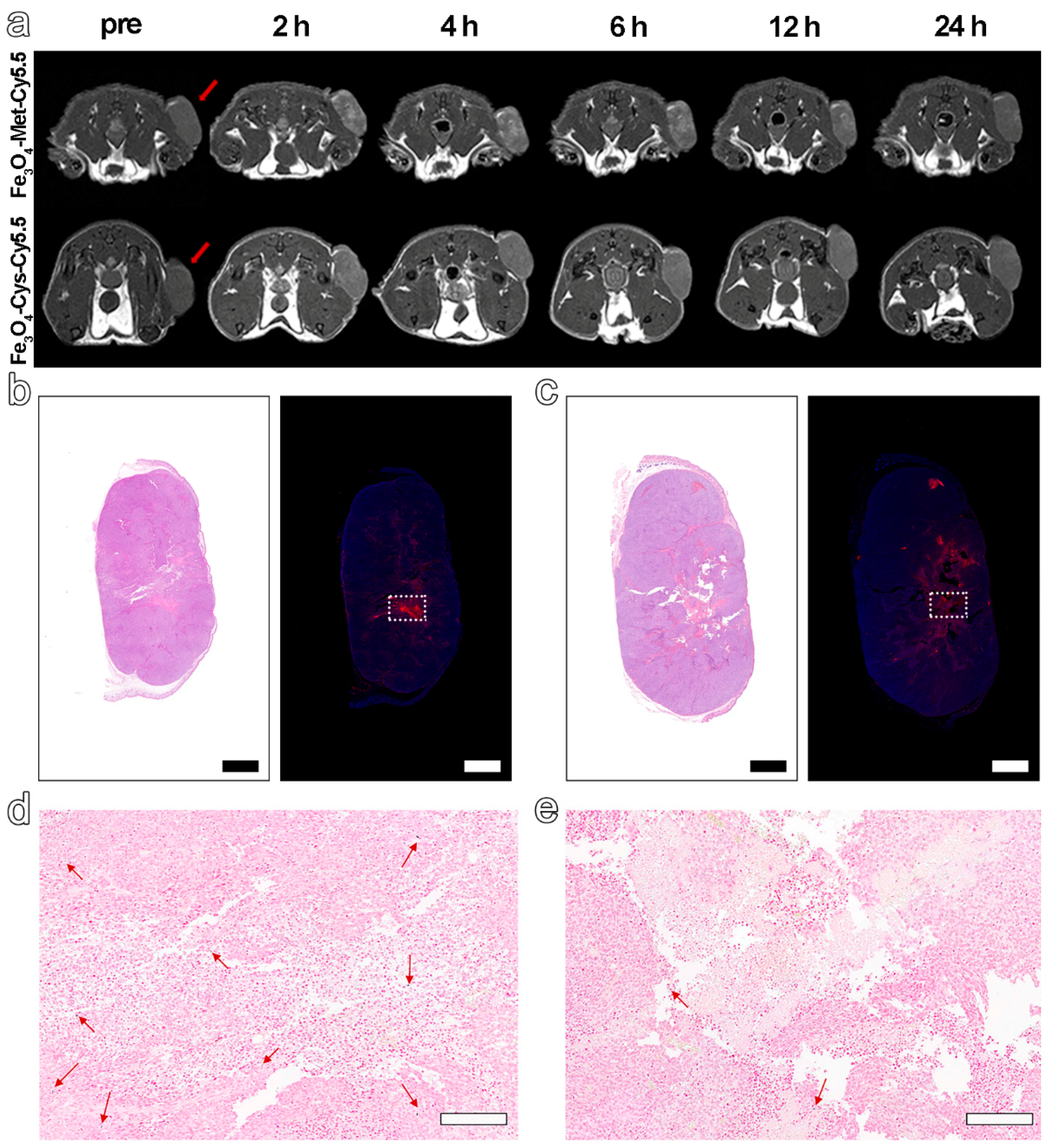
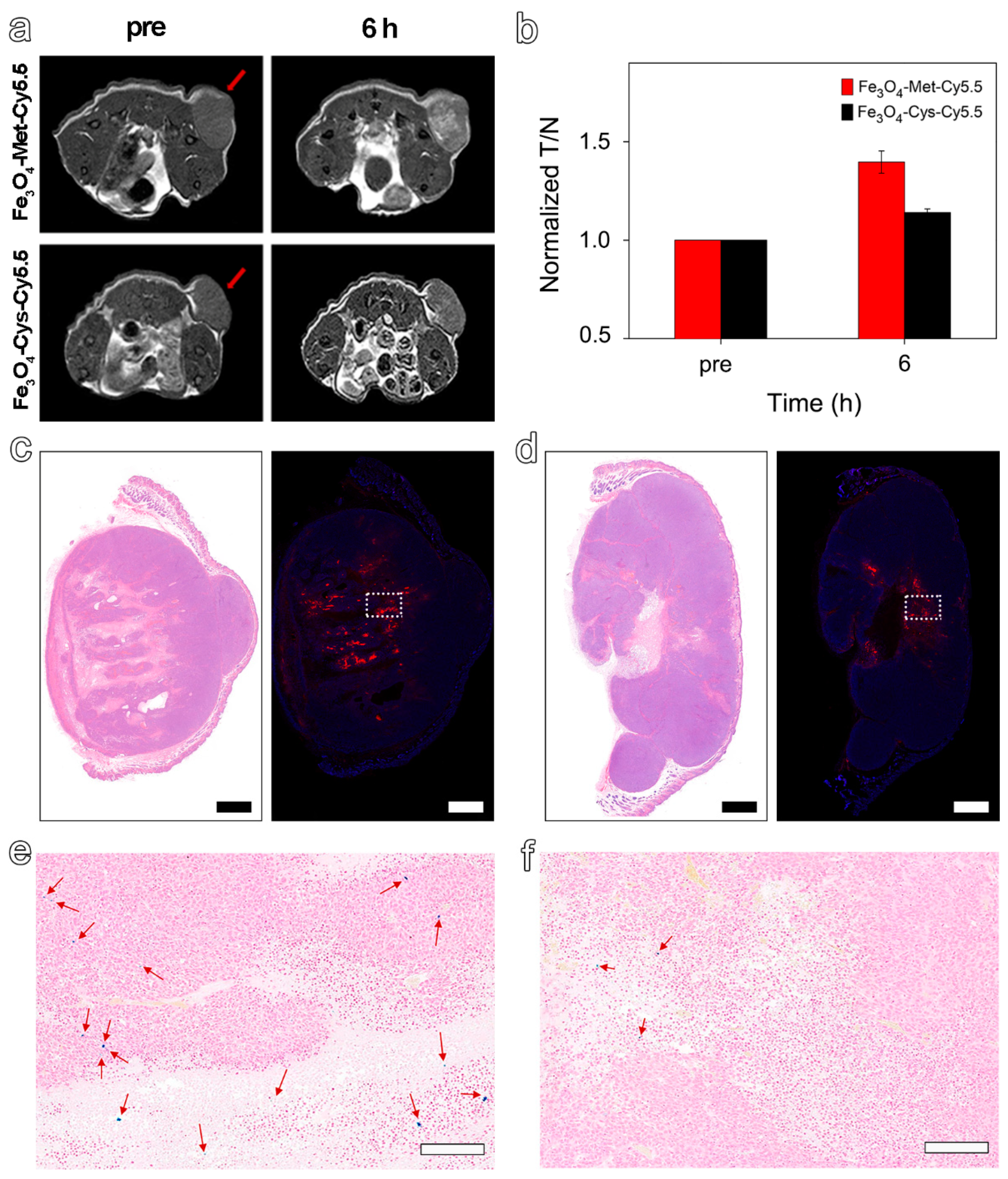
Publisher’s Note: MDPI stays neutral with regard to jurisdictional claims in published maps and institutional affiliations. |
© 2022 by the authors. Licensee MDPI, Basel, Switzerland. This article is an open access article distributed under the terms and conditions of the Creative Commons Attribution (CC BY) license (https://creativecommons.org/licenses/by/4.0/).
Share and Cite
Yang, L.; Afshari, M.J.; Ge, J.; Kou, D.; Chen, L.; Zhou, D.; Li, C.; Wu, S.; Zhang, L.; Zeng, J.; et al. Functionalized Ultrasmall Iron Oxide Nanoparticles for T1-Weighted Magnetic Resonance Imaging of Tumor Hypoxia. Molecules 2022, 27, 6929. https://doi.org/10.3390/molecules27206929
Yang L, Afshari MJ, Ge J, Kou D, Chen L, Zhou D, Li C, Wu S, Zhang L, Zeng J, et al. Functionalized Ultrasmall Iron Oxide Nanoparticles for T1-Weighted Magnetic Resonance Imaging of Tumor Hypoxia. Molecules. 2022; 27(20):6929. https://doi.org/10.3390/molecules27206929
Chicago/Turabian StyleYang, Lei, Mohammad Javad Afshari, Jianxian Ge, Dandan Kou, Lei Chen, Dandan Zhou, Cang Li, Shuwang Wu, Leshuai Zhang, Jianfeng Zeng, and et al. 2022. "Functionalized Ultrasmall Iron Oxide Nanoparticles for T1-Weighted Magnetic Resonance Imaging of Tumor Hypoxia" Molecules 27, no. 20: 6929. https://doi.org/10.3390/molecules27206929
APA StyleYang, L., Afshari, M. J., Ge, J., Kou, D., Chen, L., Zhou, D., Li, C., Wu, S., Zhang, L., Zeng, J., Zhong, J., Stauber, R. H., & Gao, M. (2022). Functionalized Ultrasmall Iron Oxide Nanoparticles for T1-Weighted Magnetic Resonance Imaging of Tumor Hypoxia. Molecules, 27(20), 6929. https://doi.org/10.3390/molecules27206929







